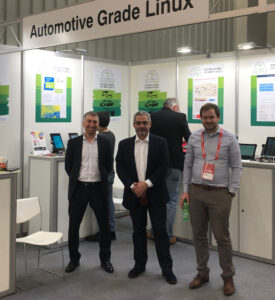EPAM, a global provider of software engineering and IT consulting services, is making strides in the auto industry by connecting the infotainment side of the car and the safety side of the car, all with the help of open source Xen hypervisor.

The EPAM team at the AGL booth
Recently, at Embedded World, EPAM was featured in the Automotive Grade Linux (AGL) booth, another Linux Foundation Project, showing off the power of open source tech innovating on historically inefficient systems and processes. EPAM demonstrated their digital cockpit, that can be used by Car OEMs and Tier 1 OEMs to design Android or AGL based mixed safety head-unit.
What is the Xen Powered Virtual Cockpit?
A digital cockpit typically comes standard in most modern vehicles and includes at least two components, an instrumental cluster which includes the speedometer, tachometer, odometer, which are safety regulated, and the infotainment cluster, which controls things such as the multimedia and navigation systems and is not safety regulated.
Because of the industry safety requirements surrounding the instrumental cluster, two independent computers within the vehicle are required. Given the level of innovation happening in the auto industry today, using independent computers adds to the complexity and cost of running these systems in-vehicle.
By using the Xen hypervisor, EPAM is able to run these clusters on the same computer, but give each cluster its own isolated space via virtualization. This solves two big issues facing the industry today. First, it addresses the safety regulation issue, second it it much more efficiency to use virtualized system vs two computer systems.
You can design the head-unit using safety compliant system for the instrumental cluster and non-safety compliant software for the infotainment cluster and maintain the required safety compliant level of the head-unit. This is why virtualization is the right approach as it allows for consolidation of the two systems or more for a “mixed safety system.”
Why Xen Hypervisors?
 Xen, having been around for more than 15 years, is the only open source solution that is mature enough. Xen is supporting different ways of peripherals virtualization, that is extremely important for head-unit designers, particularly as GPU, Imaging, and Audio peripherals share safety compliant requirements.
Xen, having been around for more than 15 years, is the only open source solution that is mature enough. Xen is supporting different ways of peripherals virtualization, that is extremely important for head-unit designers, particularly as GPU, Imaging, and Audio peripherals share safety compliant requirements.
EPAM’s digital cockpit concept is just one of many ways in which Xen is driving the auto industry forward.
What’s Next?
To further streamline the safety certification process for Xen, EPAM, as well as other stakeholders in the Xen community, auto industry and embedded tech space will gather for a developer meeting to discuss ways to move this initiative forward. More to come one this so please stay tuned.
Additionally, if you’d like to be part of the innovation taking place within the Xen Project, the annual Xen Developer and Design Summit is taking place on July 9-11, 2019. Join us in Chicago to learn from Xen experts and network with the community. To learn more about speaking opportunities, sponsorships or attending, please visit the Xen Summit Website.
